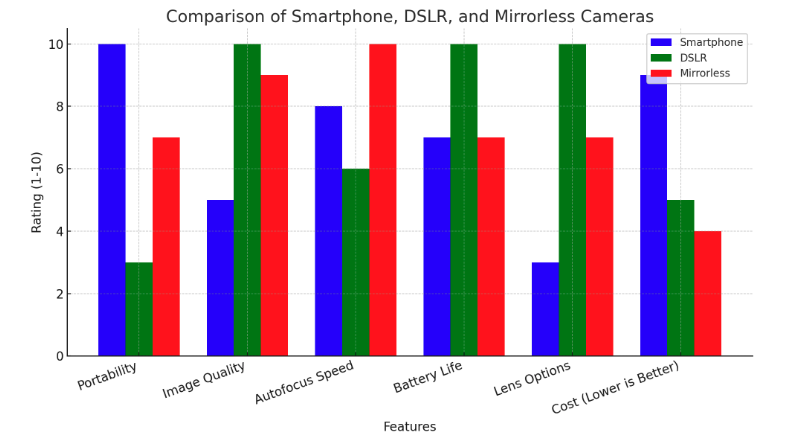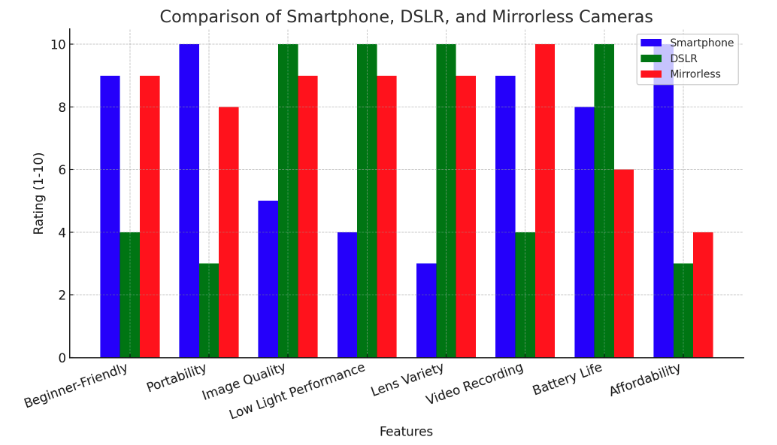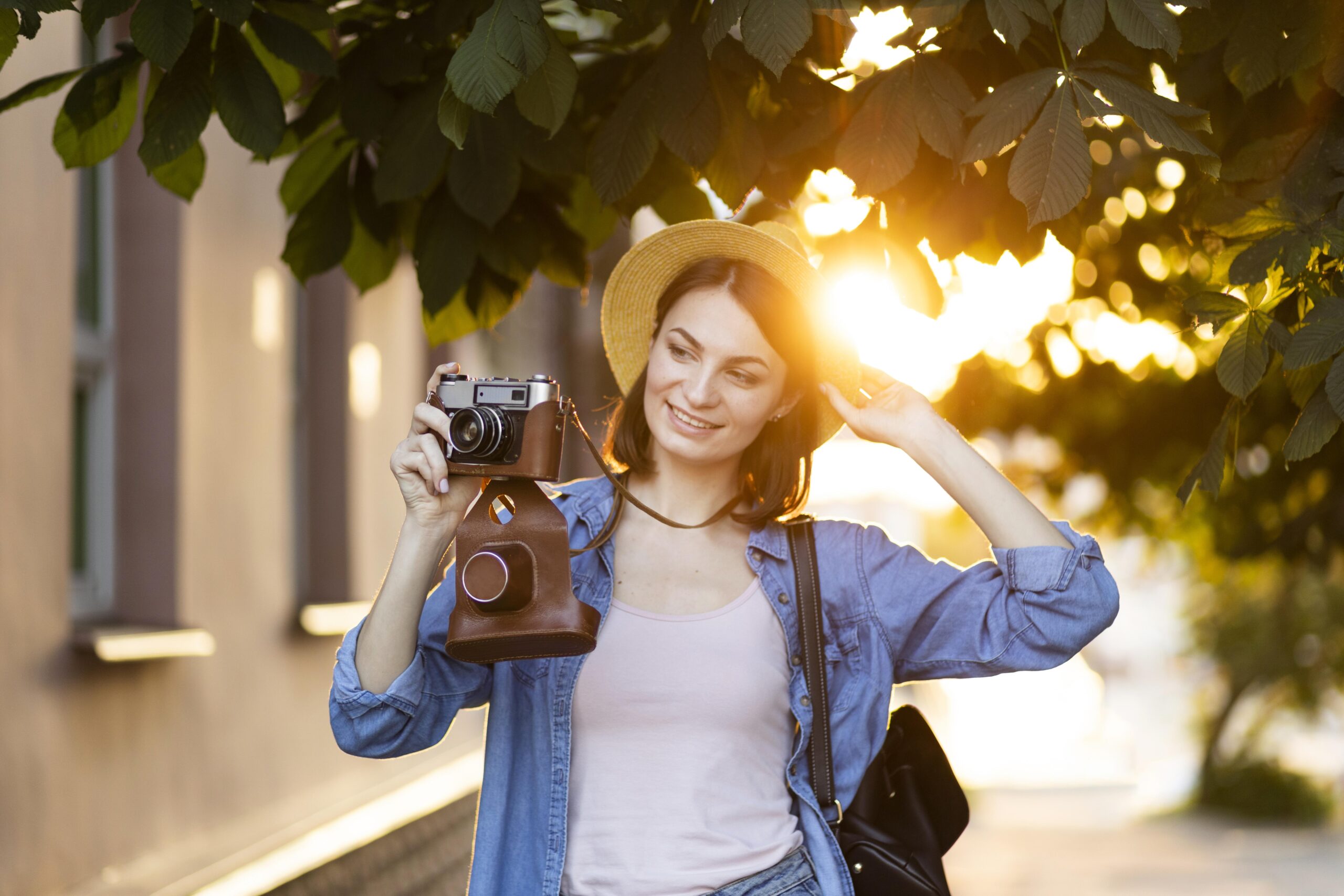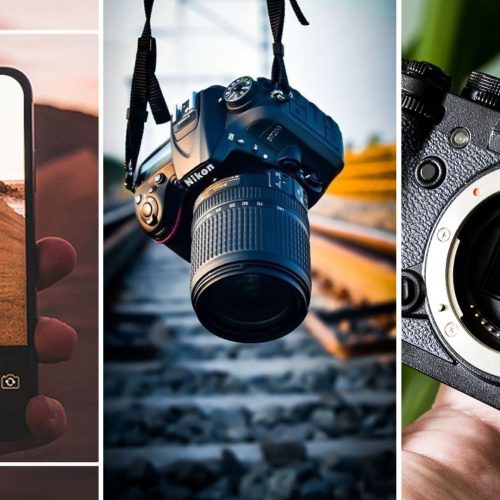In today’s world, photography and videography have become more accessible than ever. Using a smartphone, a DSLR, or a mirrorless camera, each device offers unique advantages. But which one is the best for your needs? In this blog, we’ll compare these three types of cameras based on image quality, portability, versatility, and cost.

1. Understanding the Basics
Smartphones
Smartphone cameras have advanced significantly, with AI-powered features, multiple lenses, and computational photography. They are perfect for everyday photography, social media content, and casual shoots.
- Pros:
✔️ Always with you, highly portable.
✔️ Software & AI-enhanced image processing.
✔️ Easy faster sharing and editing with apps. - Cons:
❌ Smaller sensors limit image quality in low light.
❌ Limited manual controls.
❌ Optical zoom is restricted compared to dedicated cameras.
DSLR (Digital Single-Lens Reflex) Cameras
DSLRs have long been the standard for professional and hobbyist photographers. They use a mirror and optical viewfinder, offering precise manual control and high-quality images.
- Pros:
✔️ Large sensors for superior image quality.
✔️ Extensive lens selection.
✔️ Great battery life. - Cons:
❌ Bulky and heavy.
❌ Slower in live-view autofocus compared to mirrorless cameras.
❌ Moving parts (mirror mechanism) make them less compact.
Mirrorless Cameras
Mirrorless cameras offer DSLR-like quality without the bulky mirror mechanism. They use electronic viewfinders or LCD screens, making them compact yet powerful.
- Pros:
✔️ Lighter and more compact than DSLRs.
✔️ Fast and accurate autofocus.
✔️ Excellent video capabilities. - Cons:
❌ Battery life is shorter than DSLRs.
❌ Fewer native lens options compared to DSLRs (though growing).
❌ Some models can be expensive.
2. Image Quality Comparison
- Low Light Performance: DSLRs and mirrorless cameras, with their larger sensors, perform significantly better in low light than smartphones. Smartphones rely on AI and software processing to compensate for small sensor limitations.
- Dynamic Range & Detail: DSLRs and mirrorless cameras capture more details in highlights and shadows, making them ideal for professional work. Smartphones tend to over-process images.
- Bokeh & Depth of Field: While smartphones use software-based portrait modes, DSLRs and mirrorless cameras achieve natural background blur through lens optics.
3. Portability & Convenience
- Smartphones win in terms of convenience. They fit in your pocket and are always ready to capture a moment.
- Mirrorless cameras are a middle ground, offering high-quality results while being more compact than DSLRs.
- DSLRs are bulkier but are still preferred by professionals for their durability and reliability.
4. Video Capabilities
- Smartphones excel in video stabilization and ease of use, making them perfect for vlogging.
- Mirrorless cameras dominate in high-quality video recording, with features like 4K, slow-motion, and advanced color grading options.
- DSLRs still produce excellent video but often lack advanced autofocus in live view.

5. Which One Should You Choose?
|
Category |
Smartphone |
DSLR |
Mirrorless |
|
Best for Beginners |
✅ |
❌ |
✅ |
|
Portability |
✅ |
❌ |
✅ |
|
Image Quality |
❌ |
✅ |
✅ |
|
Low Light Performance |
❌ |
✅ |
✅ |
|
Lens Variety |
❌ |
✅ |
✅ |
|
Video Recording |
✅ |
❌ |
✅ |
|
Battery Life |
✅ |
✅ |
❌ |
|
Affordability |
✅ |
❌ |
❌ |
Each camera type has its strengths and weaknesses, and the best choice depends on your needs. If you’re a casual photographer, a smartphone is enough. If you’re serious about photography, a mirrorless or DSLR camera will give you better creative control and image quality.
Are you considering upgrading your camera? Let me know in the comments what works best for you!





